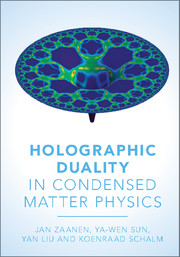Book contents
- Frontmatter
- Contents
- Preface
- 1 Introduction
- 2 Condensed matter: the charted territory
- 3 Condensed matter: the challenges
- 4 Large-N field theories for holography and condensed matter
- 5 The AdS/CFT correspondence as computational device: the dictionary
- 6 Finite-temperature magic: black holes and holographic thermodynamics
- 7 Holographic hydrodynamics
- 8 Finite density: the Reissner–Nordström black hole and strange metals
- 9 Holographic photoemission and the RN metal: the fermions as probes
- 10 Holographic superconductivity
- 11 Holographic Fermi liquids: the stable Fermi liquid and the electron star as holographic dual
- 12 Breaking translational invariance
- 13 AdS/CMT from the top down
- 14 Outlook: holography and quantum matter
- References
- Index
12 - Breaking translational invariance
Published online by Cambridge University Press: 05 November 2015
- Frontmatter
- Contents
- Preface
- 1 Introduction
- 2 Condensed matter: the charted territory
- 3 Condensed matter: the challenges
- 4 Large-N field theories for holography and condensed matter
- 5 The AdS/CFT correspondence as computational device: the dictionary
- 6 Finite-temperature magic: black holes and holographic thermodynamics
- 7 Holographic hydrodynamics
- 8 Finite density: the Reissner–Nordström black hole and strange metals
- 9 Holographic photoemission and the RN metal: the fermions as probes
- 10 Holographic superconductivity
- 11 Holographic Fermi liquids: the stable Fermi liquid and the electron star as holographic dual
- 12 Breaking translational invariance
- 13 AdS/CMT from the top down
- 14 Outlook: holography and quantum matter
- References
- Index
Summary
Symmetry comes first in physics and we have seen its prominent role in holography. When one wants to compare the results and insights gained in holography up to this point with the physics of electron systems in solids, there is one crucial form of symmetry that does not match. The holographic systems described so far all live in the Galilean continuum while electron systems live in crystals. In crystals, the background lattice formed by the ions breaks the Galilean invariance of space.
This chapter is dedicated to the effects of translational symmetry breaking on holographic matter. At the time of writing, this issue is still being intensely pursued as a research subject. Although rapid progress is being made, it is far from completely settled. The reasons are of a “technical” nature. The breaking of translations in the boundary implies that this symmetry is also broken in the spatial directions in the bulk. Finding solutions of Einstein's equations when translational symmetry is broken is a very challenging exercise – in the absence of this symmetry the non-linear nature of general relativity comes out in force. However, this hard work pays off for the boundary physics: it adds quite a bit of condensed matter realism to the holographic computations, especially when it comes to transport properties.
As we will review in section 12.2, the optical conductivity of the holographic strange-metal/superconductor system in the presence of a lattice potential looks surprisingly similar to the experimental conductivities measured in cuprates, in fact much more so than any other theoretical result that has appeared in the 25-year history of the subject. In section 12.5 two equally credible holographic mechanisms that offer potential explanations for the famous linear-in-temperature resistivity of the cuprate strange metals as discussed in section 3.6.2 will be introduced. Although less is known to date regarding the effects of a lattice on the fermion spectral functions, some first results shed a quite surprising light on the effects of Umklapp on the strange-metal “un-particles” (section 12.3). The discovery of a new form of “algebraic” insulating state will be revealed in section 12.4. Under the influence of a unidirectional periodic potential, these un-particles form states that are in one direction insulating, while they stay metallic in the other directions.
- Type
- Chapter
- Information
- Holographic Duality in Condensed Matter Physics , pp. 417 - 469Publisher: Cambridge University PressPrint publication year: 2015



